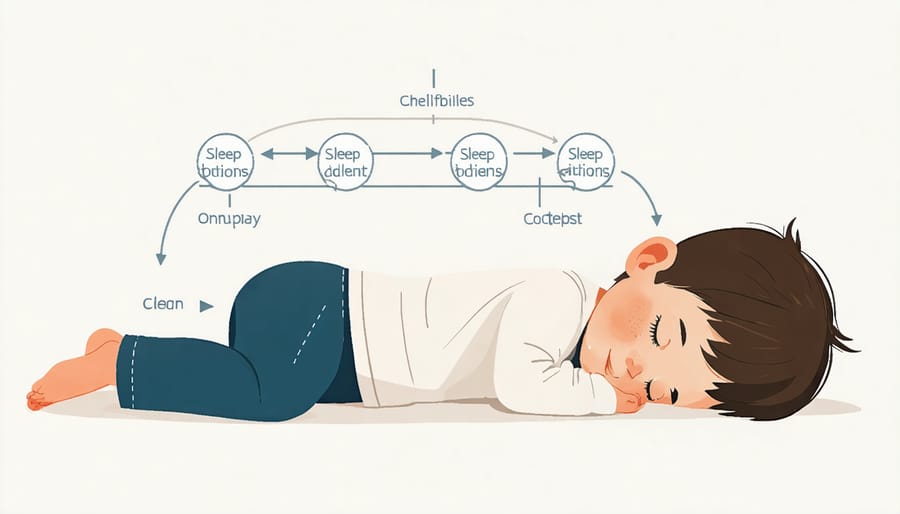Establish a consistent nap schedule that aligns with your child’s natural sleep-wake cycles, targeting the same 30-minute window each day for optimal sleep and mental health. Create a calming pre-nap routine lasting 10-15 minutes, incorporating gentle activities like reading or soft music to signal rest time. Darken the room to 60-70% light reduction, maintaining a comfortable temperature between 68-72°F (20-22°C) to promote quality sleep.
Children between ages 1-3 typically need 1-2 naps daily totaling 2-3 hours, while preschoolers may benefit from a single 1-hour afternoon nap. Watch for drowsy signs like eye-rubbing or decreased activity, then initiate the nap routine before overtiredness sets in. Consider using white noise at 50-60 decibels to mask environmental sounds and maintain consistent sleep conditions.
A well-rested child shows improved emotional regulation, learning capacity, and behavioral outcomes. Partner with caregivers and teachers to maintain nap consistency across all environments, adapting the schedule as your child grows while preserving the essential elements of their sleep routine.
The Science Behind Children’s Sleep Cycles

How Naps Impact Nighttime Sleep
Daytime naps and nighttime sleep are intricately connected through our natural sleep-wake cycles. While naps can be beneficial, their timing and duration significantly influence how well your child sleeps at night.
For most children, well-timed naps enhance nighttime sleep quality by preventing overtiredness. When children become too tired, their bodies produce stress hormones that make it harder to fall asleep and stay asleep at night. However, naps taken too late in the day or those that are too long can disrupt bedtime routines.
Dr. Sarah Chen, a pediatric sleep specialist, explains, “Think of your child’s sleep needs like a battery that needs regular recharging. A good nap helps maintain energy levels without overcharging, which could lead to nighttime sleep difficulties.”
The key is finding the right balance. For toddlers and preschoolers, limiting naps to 1-2 hours and ensuring they end at least 4-5 hours before bedtime typically yields the best results. This timing allows enough sleep pressure to build up for a peaceful night’s rest while still benefiting from the restorative effects of napping.
Age-Appropriate Nap Needs
Every child has unique sleep needs that evolve as they grow. For newborns (0-3 months), expect 4-5 naps daily, lasting 30 minutes to 2 hours each. These naps are typically irregular as babies are developing their circadian rhythms.
Between 3-6 months, babies usually settle into 3-4 naps per day, each lasting 1-2 hours. By 6-12 months, most infants transition to 2-3 daily naps, with the morning and afternoon naps being most crucial.
Toddlers (1-2 years) generally need one long afternoon nap, lasting about 1-3 hours. This pattern typically continues until age 3-4, though some children may stop napping earlier. Preschoolers (3-5 years) might still benefit from a 1-hour afternoon rest, even if they don’t sleep.
Remember that these are guidelines, not strict rules. Watch your child’s mood and behavior for signs that their nap schedule needs adjustment. A well-rested child is typically more alert, happier, and better able to learn and play throughout the day.
Creating Effective Nap Time Rules
Consistent Nap Schedule
A consistent nap schedule is like setting your child’s internal clock – it helps their body and mind know when it’s time to rest. Research shows that children who nap at the same times each day tend to fall asleep more easily and enjoy better quality rest.
To establish a regular nap schedule, start by observing your child’s natural sleepy cues, such as rubbing eyes, becoming cranky, or slowing down in activity. These signals typically appear at similar times each day and can guide you in setting appropriate nap times.
For most toddlers, the ideal first nap usually falls between 9:30 and 10:30 AM, with a second nap (if needed) around 1:30 to 2:30 PM. However, remember that every child is unique, and these times can be adjusted based on your child’s specific needs and your family’s routine.
Consistency is key – try to stick to the same nap times even on weekends. Create a pre-nap routine that includes calming activities like reading a story or gentle rocking. This helps signal to your child that it’s time to wind down.
If you’re struggling with schedule changes or transitions, make adjustments gradually – shifting nap times by 15-minute increments over several days. This gentle approach helps your child adapt without becoming overtired or resistant.
Remember that as your child grows, their nap needs will change. Stay attentive to their cues and be prepared to adjust the schedule accordingly while maintaining the consistency they need for healthy sleep habits.
Ideal Nap Environment
Creating a sleep-conducive environment is essential for successful napping. Start by finding a quiet, comfortable space where your child can rest undisturbed. The room should be neither too hot nor too cold – experts recommend maintaining a temperature between 68-72°F (20-22°C).
Lighting plays a crucial role in promoting quality sleep. Use blackout curtains or shades to create a dimly lit atmosphere, even during daytime naps. This helps signal to your child’s brain that it’s time to rest. If complete darkness isn’t possible, consider using a sleep mask for older children.
Background noise can be managed with white noise machines or gentle lullabies played at a low volume. These sounds help mask sudden disturbances that might wake your child. Keep the noise level consistent throughout naptime.
The sleeping surface matters too. Whether it’s a crib, bed, or designated nap mat, ensure it’s clean, firm, and free from excess toys or blankets. A light blanket and a favorite comfort item can help your child feel secure and relaxed.
Pay attention to clothing comfort. Dress your child in breathable, loose-fitting clothes that won’t restrict movement or cause overheating. Remove any items that might be uncomfortable or distracting, such as shoes or accessories.
Remember that each child is different – what works for one might not work for another. Observe your child’s preferences and adjust the environment accordingly while maintaining safety guidelines.

Pre-Nap Routine
A consistent pre-nap routine helps children understand when it’s time to wind down and prepares their bodies for rest. Start by dimming the lights and reducing noise levels about 15-20 minutes before naptime. This signals to your child’s brain that it’s time to transition from active play to rest.
Create a calming sequence of activities that you can repeat daily. For example, begin with a quick cleanup of toys, followed by a diaper change or bathroom visit, and then settle into a cozy reading spot. Reading one or two short stories helps children decompress while creating a special bonding moment.
Many parents find success with gentle relaxation techniques like soft belly breathing or humming a familiar lullaby. Keep the routine simple and achievable – complicated procedures can become stressful for both you and your child.
Consider using transitional objects, such as a special blanket or stuffed animal, to provide comfort and security. These items become powerful sleep cues when consistently incorporated into the pre-nap routine.
Remember to maintain a consistent naptime schedule, as children thrive on predictability. If your child seems resistant, stay patient and calm. Your peaceful demeanor will help them feel secure and ready to rest. Some children might need extra snuggles or back rubs during this transition period, and that’s perfectly normal.
Watch for your child’s sleep cues – yawning, eye rubbing, or becoming quieter – and begin your routine when you notice these signals. This timing helps work with their natural sleep rhythm rather than against it.

Common Nap Time Challenges
Nap Resistance
It’s completely normal for children to resist nap time – in fact, it’s one of the most common challenges parents and caregivers face when dealing with sleep resistance. Understanding why your child fights naps is the first step toward finding effective solutions.
Children often resist naps because they’re afraid of missing out on activities or experiencing separation anxiety. Sometimes, they might be overtired, which paradoxically makes it harder for them to settle down. The key is to remain calm and consistent in your approach.
Try creating a pre-nap routine that helps your child wind down gradually. This might include reading a story, singing a quiet song, or gentle cuddling. Keep the room slightly darkened and maintain a comfortable temperature. White noise can also help block out distracting sounds that might keep your child alert.
If your child consistently fights naps, consider adjusting their schedule. They might need an earlier or later nap time to align with their natural sleep rhythms. Watch for signs of tiredness like rubbing eyes, becoming cranky, or decreased activity levels.
Remember that every child is different, and what works for one may not work for another. Stay patient and be willing to adjust your approach based on your child’s unique needs. With consistency and understanding, most children eventually adapt to a regular nap routine that works for everyone.
Inconsistent Nap Length
Nap lengths can vary significantly from day to day, which often concerns parents and caregivers. It’s important to understand that some variation is completely normal and doesn’t necessarily indicate a problem. Children, like adults, may need different amounts of sleep depending on their activity levels, growth spurts, or recent sleep quality.
To manage inconsistent nap lengths effectively, start by tracking your child’s sleep patterns for a week. Note down nap duration, mood upon waking, and any factors that might have influenced the nap length. This information can help you identify patterns and adjust your approach accordingly.
If your child consistently takes shorter naps, try these strategies:
– Ensure the sleep environment is consistently dark, quiet, and at a comfortable temperature
– Maintain the same pre-nap routine to signal it’s time to rest
– Consider adjusting nap timing based on your child’s natural sleepy cues
– Be patient during transitions between sleep cycles
For longer-than-usual naps, evaluate whether your child might be going through a growth spurt or recovering from a busy period. While it’s generally fine to let children sleep longer occasionally, try to gently wake them if the extended nap might interfere with bedtime.
Remember that nap needs change as children grow. What works one month might need adjustment the next. Stay flexible while maintaining consistent sleep cues and routines to help your child get the rest they need, regardless of nap duration.
Signs It’s Time to Adjust Nap Rules
Children’s sleep needs evolve constantly, and being attentive to their changing patterns helps maintain healthy nap routines. Here are clear signs that it’s time to adjust your child’s nap schedule:
Bedtime becomes a battle: If your child strongly resists their usual bedtime or takes more than 30 minutes to fall asleep, their nap timing might need adjustment. This often happens when afternoon naps run too late or are too long.
Changes in morning wake-up time: When your child consistently wakes much earlier or later than usual, it’s a signal that their sleep-wake cycle needs rebalancing. This might mean shortening nap duration or shifting nap times.
Difficulty falling asleep for naps: If your little one fights naps they previously took easily, they might be ready for a schedule change. Some children may need their nap time moved earlier or later to match their natural sleepiness windows.
Mid-day energy patterns shift: Notice when your child is naturally most tired. If their usual nap time no longer aligns with these periods of low energy, consider adjusting accordingly.
Making these changes requires patience and observation. Start with small 15-minute adjustments to nap timing, and maintain the new schedule for at least a week before making further changes. Pay attention to your child’s mood and energy levels throughout the day as indicators of whether the adjustments are working.
Remember that major life changes, such as starting daycare or transitioning to a new sibling, can temporarily affect nap patterns. During these times, children might need extra flexibility in their schedule while maintaining consistent pre-nap routines to provide security and predictability.
If you’re unsure about making changes, keep a sleep diary for a week, noting nap times, duration, and any unusual behaviors. This information can help identify patterns and guide appropriate adjustments to better serve your child’s evolving sleep needs.
Establishing and maintaining consistent nap time rules is a journey that requires patience, understanding, and flexibility. As we’ve explored throughout this guide, successful nap routines contribute significantly to a child’s physical health, emotional well-being, and cognitive development.
Remember that every child is unique, and what works for one may not work for another. The key is to remain consistent with your chosen approach while being attentive to your child’s individual needs and cues. Start by creating a calm, comfortable sleep environment and maintaining regular nap schedules that align with your child’s natural sleep patterns.
As pediatric sleep consultant Maria Thompson notes, “The most successful nap routines are those that parents commit to consistently, even when facing temporary setbacks.” Don’t be discouraged by occasional challenges – they’re a normal part of the process.
Consider keeping a sleep diary to track what works best for your child, and be prepared to adjust your approach as they grow and their sleep needs change. Remember that implementing nap time rules isn’t just about managing your child’s sleep – it’s about fostering healthy sleep habits that will benefit them throughout their lives.
By following these guidelines and maintaining a positive attitude, you’re helping your child develop essential sleep skills while creating peaceful moments in your daily routine. Trust in the process, celebrate small victories, and know that your efforts in establishing good nap habits are invaluable to your child’s development.







